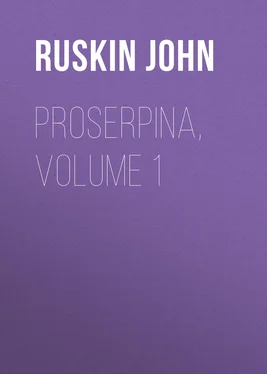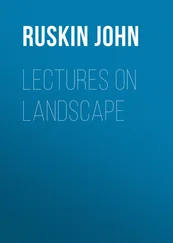John Ruskin - Proserpina, Volume 1
Здесь есть возможность читать онлайн «John Ruskin - Proserpina, Volume 1» — ознакомительный отрывок электронной книги совершенно бесплатно, а после прочтения отрывка купить полную версию. В некоторых случаях можно слушать аудио, скачать через торрент в формате fb2 и присутствует краткое содержание. Жанр: foreign_antique, Биология, literature_19, foreign_edu, на английском языке. Описание произведения, (предисловие) а так же отзывы посетителей доступны на портале библиотеки ЛибКат.
- Название:Proserpina, Volume 1
- Автор:
- Жанр:
- Год:неизвестен
- ISBN:нет данных
- Рейтинг книги:3 / 5. Голосов: 1
-
Избранное:Добавить в избранное
- Отзывы:
-
Ваша оценка:
- 60
- 1
- 2
- 3
- 4
- 5
Proserpina, Volume 1: краткое содержание, описание и аннотация
Предлагаем к чтению аннотацию, описание, краткое содержание или предисловие (зависит от того, что написал сам автор книги «Proserpina, Volume 1»). Если вы не нашли необходимую информацию о книге — напишите в комментариях, мы постараемся отыскать её.
Proserpina, Volume 1 — читать онлайн ознакомительный отрывок
Ниже представлен текст книги, разбитый по страницам. Система сохранения места последней прочитанной страницы, позволяет с удобством читать онлайн бесплатно книгу «Proserpina, Volume 1», без необходимости каждый раз заново искать на чём Вы остановились. Поставьте закладку, и сможете в любой момент перейти на страницу, на которой закончили чтение.
Интервал:
Закладка:
11. But there is one minor division yet. You see I have drawn the central part of the moss plant ( b , Fig. 2,) half in outline and half in black; and that, similarly, in the upper group, which is too small to show the real roots, the base of the cluster is black. And you remember, I doubt not, how often in gathering what most invited gathering, of deep green, starry, perfectly soft and living wood-moss, you found it fall asunder in your hand into multitudes of separate threads, each with its bright green crest, and long root of blackness.
That blackness at the root—though only so notable in this wood-moss and collateral species, is indeed a general character of the mosses, with rare exceptions. It is their funeral blackness;—that, I perceive, is the way the moss leaves die. They do not fall—they do not visibly decay. But they decay in visibly, in continual secession, beneath the ascending crest. They rise to form that crest, all green and bright, and take the light and air from those out of which they grew;—and those, their ancestors, darken and die slowly, and at last become a mass of mouldering ground. In fact, as I perceive farther, their final duty is so to die. The main work of other leaves is in their life,—but these have to form the earth out of which all other leaves are to grow. Not to cover the rocks with golden velvet only, but to fill their crannies with the dark earth, through which nobler creatures shall one day seek their being.
12. "Grant but as many sorts of mind as moss." Pope could not have known the hundredth part of the number of 'sorts' of moss there are; and I suppose he only chose the word because it was a monosyllable beginning with m, and the best English general expression for despised and minute structures of plants. But a fate rules the words of wise men, which makes their words truer, and worth more, than the men themselves know. No other plants have so endless variety on so similar a structure as the mosses; and none teach so well the humility of Death. As for the death of our bodies, we have learned, wisely, or unwisely, to look the fact of that in the face. But none of us, I think, yet care to look the fact of the death of our minds in the face. I do not mean death of our souls, but of our mental work. So far as it is good art , indeed, and done in realistic form, it may perhaps not die; but so far as it was only good thought —good, for its time, and apparently a great achievement therein—that good, useful thought may yet in the future become a foolish thought, and then die quite away,—it, and the memory of it,—when better thought and knowledge come. But the better thought could not have come if the weaker thought had not come first, and died in sustaining the better. If we think honestly, our thoughts will not only live usefully, but even perish usefully—like the moss—and become dark, not without due service. But if we think dishonestly, or malignantly, our thoughts will die like evil fungi,—dripping corrupt dew.
13. But farther. If you have walked moorlands enough to know the look of them, you know well those flat spaces or causeways of bright green or golden ground between the heathy rock masses; which signify winding pools and inlets of stagnant water caught among the rocks;—pools which the deep moss that covers them— blanched , not black, at the root,—is slowly filling and making firm; whence generally the unsafe ground in the moorland gets known by being mossy instead of heathy; and is at last called by its riders, briefly, 'the Moss': and as it is mainly at these same mossy places that the riding is difficult, and brings out the gifts of horse and rider, and discomfits all followers not similarly gifted, the skilled crosser of them got his name, naturally, of 'moss-rider,' or moss-trooper. In which manner the moss of Norway and Scotland has been a taskmaster and Maker of Soldiers, as yet, the strongest known among natural powers. The lightning may kill a man, or cast down a tower, but these little tender leaves of moss—they and their progenitors—have trained the Northern Armies.
14. So much for the human meaning of that decay of the leaves. Now to go back to the little creatures themselves. It seems that the upper part of the moss fibre is especially un decaying among leaves; and the lower part, especially decaying. That, in fact, a plant of moss-fibre is a kind of persistent state of what is, in other plants, annual. Watch the year's growth of any luxuriant flower. First it comes out of the ground all fresh and bright; then, as the higher leaves and branches shoot up, those first leaves near the ground get brown, sickly, earthy,—remain for ever degraded in the dust, and under the dashed slime in rain, staining, and grieving, and loading them with obloquy of envious earth, half-killing them,—only life enough left in them to hold on the stem, and to be guardians of the rest of the plant from all they suffer;—while, above them, the happier leaves, for whom they are thus oppressed, bend freely to the sunshine, and drink the rain pure.
The moss strengthens on a diminished scale, intensifies, and makes perpetual, these two states,—bright leaves above that never wither, leaves beneath that exist only to wither.
15. I have hitherto spoken only of the fading moss as it is needed for change into earth. But I am not sure whether a yet more important office, in its days of age, be not its use as a colour.
We are all thankful enough—as far as we ever are so—for green moss, and yellow moss. But we are never enough grateful for black moss. The golden would be nothing without it, nor even the grey.
It is true that there are black lichens enough, and brown ones: nevertheless, the chief use of lichens is for silver and gold colour on rocks; and it is the dead moss which gives the leopard-like touches of black. And yet here again—as to a thing I have been looking at and painting all my life—I am brought to pause, the moment I think of it carefully. The black moss which gives the precious Velasquez touches, lies, much of it, flat on the rocks; radiating from its centres—powdering in the fingers, if one breaks it off, like dry tea. Is it a black species?—or a black-parched state of other species, perishing for the sake of Velasquez effects, instead of accumulation of earth? and, if so, does it die of drought, accidentally, or, in a sere old age, naturally? and how is it related to the rich green bosses that grow in deep velvet? And there again is another matter not clear to me. One calls them 'velvet' because they are all brought to an even surface at the top. Our own velvet is reduced to such trimness by cutting. But how is the moss trimmed? By what scissors? Carefullest Elizabethan gardener never shaped his yew hedge more daintily than the moss fairies smooth these soft rounded surfaces of green and gold. And just fancy the difference, if they were ragged! If the fibres had every one of them leave to grow at their own sweet will, and to be long or short as they liked, or, worse still, urged by fairy prizes into laboriously and agonizingly trying which could grow longest. Fancy the surface of a spot of competitive moss!
16. But how is it that they are subdued into that spherical obedience, like a crystal of wavellite? 11 11 The reader should buy a small specimen of this mineral; it is a useful type of many structures.
Strange—that the vegetable creatures growing so fondly on rocks should form themselves in that mineral-like manner. It is true that the tops of all well-grown trees are rounded, on a large scale, as equally; but that is because they grow from a central stem, while these mossy mounds are made out of independent filaments, each growing to exactly his proper height in the sphere—short ones outside, long in the middle. Stop, though; is that so? I am not even sure of that; perhaps they are built over a little dome of decayed moss below. 12 12 Lucca, Aug. 9th, 1874. —I have left this passage as originally written, but I believe the dome is of accumulated earth. Bringing home, here, evening after evening, heaps of all kinds of mosses from the hills among which the Archbishop Ruggieri was hunting the wolf and her whelps in Ugolino's dream, I am more and more struck, every day, with their special function as earth-gatherers, and with the enormous importance to their own brightness, and to our service, of that dark and degraded state of the inferior leaves. And it fastens itself in my mind mainly as their distinctive character, that as the leaves of a tree become wood, so the leaves of a moss become earth, while yet a normal part of the plant. Here is a cake in my hand weighing half a pound, bright green on the surface, with minute crisp leaves; but an inch thick beneath in what looks at first like clay, but is indeed knitted fibre of exhausted moss. Also, I don't at all find the generalization I made from the botanical books likely to have occurred to me from the real things. No moss leaves that I can find here give me the idea of resemblance to pineapple leaves; nor do I see any, through my weak lens, clearly serrated; but I do find a general tendency to run into a silky filamentous structure, and in some, especially on a small one gathered from the fissures in the marble of the cathedral, white threads of considerable length at the extremities of the leaves, of which threads I remember no drawing or notice in the botanical books. Figure 1 represents, magnified, a cluster of these leaves, with the germinating stalk springing from their centre; but my scrawl was tired and careless, and for once, Mr. Burgess has copied too accurately.
I must find out how every filament grows, separately—from root to cap, through the spirally set leaves. And meanwhile I don't know very clearly so much as what a root is—or what a leaf is. Before puzzling myself any farther in examination either of moss or any other grander vegetable, I had better define these primal forms of all vegetation, as well as I can—or rather begin the definition of them, for future completion and correction. For, as my reader must already sufficiently perceive, this book is literally to be one of studies—not of statements. Some one said of me once, very shrewdly, When he wants to work out a subject, he writes a book on it. That is a very true saying in the main,—I work down or up to my mark, and let the reader see process and progress, not caring to conceal them. But this book will be nothing but process. I don't mean to assert anything positively in it from the first page to the last. Whatever I say, is to be understood only as a conditional statement—liable to, and inviting, correction. And this the more because, as on the whole, I am at war with the botanists, I can't ask them to help me, and then call them names afterwards. I hope only for a contemptuous heaping of coals on my head by correction of my errors from them;—in some cases, my scientific friends will, I know, give me forgiving aid;—but, for many reasons, I am forced first to print the imperfect statement, as I can independently shape it; for if once I asked for, or received help, every thought would be frostbitten into timid expression, and every sentence broken by apology. I should have to write a dozen of letters before I could print a line, and the line, at last, would be only like a bit of any other botanical book—trustworthy, it might be, perhaps; but certainly unreadable. Whereas now, it will rather put things more forcibly in the reader's mind to have them retouched and corrected as we go on; and our natural and honest mistakes will often be suggestive of things we could not have discovered but by wandering.
Интервал:
Закладка:
Похожие книги на «Proserpina, Volume 1»
Представляем Вашему вниманию похожие книги на «Proserpina, Volume 1» списком для выбора. Мы отобрали схожую по названию и смыслу литературу в надежде предоставить читателям больше вариантов отыскать новые, интересные, ещё непрочитанные произведения.
Обсуждение, отзывы о книге «Proserpina, Volume 1» и просто собственные мнения читателей. Оставьте ваши комментарии, напишите, что Вы думаете о произведении, его смысле или главных героях. Укажите что конкретно понравилось, а что нет, и почему Вы так считаете.












